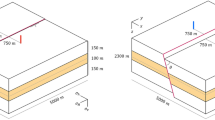Abstract
The injection of CO2 into aquifers increases fluid pressure and induces a change of the geomechanical state. This is expected to be a cause of fracture reactivation, which is an important issue for the safety of CO2 storage. Using the geomechanics module, fracture reactivation, which was induced by tensile failure, was considered for the investigation of a potential CO2 leakage. Numerical simulations were conducted to analyze the effects of the rock geomechanical properties on the fracture reactivation in a two-dimensional system, and then the properties of fracture propagation were extended to the different rock types, hard shale and weak shale, in a three-dimensional system. Changes of the stress state, rock deformation, and the pressure build-up induced by CO2 injection were examined. When a rock has a high Young’s modulus, effective stress decreases rapidly, leading to an earlier fracture reactivation. The total reduction of effective stress in the rock with a low Poisson’s ratio was less than that of the rock with a high Poisson’s ratio. The magnitude of pressure build-up is lower in the high-permeability rock, so that the fracture propagates more slowly. Hard shale’s caprock is more favorable than that of weak shale for CO2 storage because fractures are opened later, retarding the CO2 leakage. The injected CO2 flows through a preferable region with reactivated fractures in the heterogeneous caprock. This study broadens our perception of the mechanical behavior that is induced by CO2 injection and it could be helpful for the precise safety assessment of CO2 storage projects.
















Similar content being viewed by others
References
Aadnøy BS, Looyeh R (2011) Petroleum rock mechanics: drilling operations and well design. Elsevier, Amsterdam
Bachu S (2008) CO2 storage in geological media: role, means, status and barriers to deployment. Prog Energy Combust Sci 34(2):254–273. doi:10.1016/j.pecs.2007.10.001
Biot MA (1941) General theory for three-dimensional consolidation. J Appl Phys 12(2):155–164. doi:10.1063/1.1712886
Busch A, Amann A, Bertier P, Waschbuschm M, Krooss BM (2010) The significance of caprock sealing integrity for CO2 storage. In: The SPE international conference on CO2 capture, storage, and utilization. New Orleans, Louisiana, USA. doi:10.2118/139588-MS
Cappa F, Rutqvist J (2011) Modeling of coupled deformation and permeability evolution during fault reactivation induced by deep underground injection of CO2. Int J Greenh Gas Control 5(2):336–346. doi:10.1016/j.ijggc.2010.08.005
Chalaturnyk RJ (2007) Geomechanical characterization of the weyburn field for geological storage of CO2. In: The 1st Canada–US rock mechanics symposium, Vancouver, Canada
Computer Modeling Group (2015) Gem user guide: Compositional and unconventional reservoir simulator. Computer Modeling Group Ltd, Calgary
Fjaer E, Holt RM, Horsrud P, Raaen AM, Risnes R (2008) Petroleum related rock mechanics, 2nd edn. Elsevier, Amsterdam
Hurter S, Labregere D, Berge J (2007) Simulation for CO2 injection projects with compositional simulator. In: The offshore Europe, Aberdeen, Scotland. doi:10.2118/108540-MS
Lee JW, Min KB, Rutqvist J (2012) Evaluation of leakage potential considering fractures in the caprock for sequestration of CO2 in geological media. In: The 46th US rock mechanics/geomechanics symposium, Chicago, Illinois, USA
Lucier A, Zoback M, Gupta N, Ramakrishnan TS (2006) Geomechanical aspects of CO2 sequestration in a deep saline reservoir in the Ohio river valley region. Environ Geosci 13(2):85–103. doi:10.1306/eg.11230505010
Mathieson A, Midgely J, Wright I, Saoula N, Ringrose P (2011) In Salah CO2 storage JIP: CO2 sequestration monitoring and verification technologies applied at Krechba, Algeria. Energy Proc 4:3596–3603. doi:10.1016/j.egypro.2011.02.289
Rutqvist J, Stephansson O (2003) The role of hydromechanical coupling in fractured rock engineering. Hydrogeol J 11:7–40. doi:10.1007/s10040-002-0241-5
Rutqvist J, Tsang CF (2002) A study of caprock hydromechanical changes associated with CO2 injection into a brine aquifer. Environ Geol 42(2):296–305. doi:10.1007/s00254-001-0499-2
Rutqvist J, Wu YS, Tsang CF, Bodvarsson G (2002) A modeling approach for analysis of coupled multiphase fluid flow, heat transfer, and deformation in fractured porous rock. Int J Rock Mech Min Sci 39(4):429–442. doi:10.1016/s1365-1609(02)00022-9
Rutqvist J, Birkholzer JT, Cappa F, Tsang CF (2007) Estimating maximum sustainable injection pressure during geological sequestration of CO2 using coupled fluid flow and geomechanical fault-slip analysis. Energy Conv Manag 47(6):1798–1807. doi:10.1016/j.enconman.2007.01.021
Rutqvist J, Birkholzer JT, Tsang CF (2008) Coupled reservoir–geomechanical analysis of the potential for tensile and shear failure associated with CO2 injection in multilayered reservoir-caprock systems. Int J Rock Mech Min Sci 45(2):132–143. doi:10.1016/j.ijrmms.2007.04.006
Terzaghi P (1923) Die Berechning der Durchlässigkeitziffer des Tones aus dem Verlauf der hydrodynamischen Spannungserscheinungen. Akad Wissensch Wien Sitzungsber Mathnaturwissensch Klasse IIa 142(3/4):125–138
Torp TA, John G (2004) Demonstrating storage of CO2 in geological reservoirs: the Sleipner and SACS projects. Energy 29(9–10):1361–1369. doi:10.1016/j.energy.2004.03.104
Tran D, Nghiem L, Buchanan L (2009a) Aspects of coupling between petroleum reservoir flow and geomechanics. In: The 43rd US rock mechanics symposium and 4th US–Canada rock mechanics Symposium, Asheville, North Carolina, USA
Tran D, Shrivastava V, Nghiem L, Kohse B (2009b) Geomechanical risk mitigation for CO2 sequestration in saline aquifers. In: The SPE annual technical conference and exhibition, New Orleans, Louisiana, USA. doi:10.2118/125167-MS
Tran D, Nghiem L, Shrivastava V, Kohse B (2010) Study of geomechanical effects in deep aquifer CO2 storage. In: The 44th US rock mechanics symposium and 5th US–Canada rock mechanics symposium, Salt Lake City, Utah, USA
Acknowledgments
This work was supported by the Energy Efficiency & Resources of the Korea Institute of Energy Technology Evaluation and Planning (KETEP) grant funded by the Korean government Ministry of Trade, Industry & Energy (MOTIE) (No. 20132010201760).
Author information
Authors and Affiliations
Corresponding author
Rights and permissions
About this article
Cite this article
Park, S.S., Park, J., Cho, J. et al. Numerical modeling of the tensile fracture reactivation under the effects of rock geomechanical properties and heterogeneity during CO2 storage. Environ Earth Sci 75, 298 (2016). https://doi.org/10.1007/s12665-015-5134-8
Received:
Accepted:
Published:
DOI: https://doi.org/10.1007/s12665-015-5134-8




